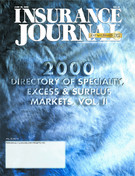After processing a record $1,524,697,215 in premiums during 1999, the Surplus Line Association of California (SLA) continued to post an increase in premium volume through May of 2000.
The overall numbers imply that the SLA is on the right track for another record-breaking year, but some important figures— such as top broker and top company statistics—have been slipping. Yes, the premium volume has increased for the first five months of 2000, but the expected major increase has not occurred, according to Pat McAuley, SLA operations supervisor, data processing department.
During the first four months of 2000, the number of premiums processed was down 2 percent, but the month of May saw record numbers. “We were 25 percent above May of last year, so that put us—so far—2 percent above the first five months of last year,” said Ted Pierce, SLA executive director.
If, in fact, this year is going to be another record-breaking year, it would indicate that perhaps there is a slight tightening of the market, according to Pierce. “But I can only say that maybe this year is going to be another huge year,” he said.
The number of policies handled in 1999 was 234,828, an increase of 16 percent over 1998. And 1999’s record premiums were a 25 percent increase over 1998.
More than $611 million of the premiums processed in 1999 were for general liability (GL) coverage—which, according to Pierce, will always be the largest category. “General liability policies just are always going to outnumber everything else,” he explained. “The number two [coverage] has pretty much steadily been errors and omissions, with fire as a close third.”
“It appears that our top broker and top company statistics have dropped, and the major drop for both is in umbrella coverage,” McAuley said.
As for the top brokers, Western Risk Specialists, Sherwood Insurance (a division of Aon Risk Services Inc.) and Marsh Risk & Insurance Services underwrote 28 percent of the 1999 premiums.
The company underwriting the largest volume in 1999 was American International Specialty Lines Insurance (an AIG company) with close to $171 million. That same company has written $49.1 million for the first five months of 2000.
Point of the compass
The top 10 brokers, Pierce said, made up 42 percent of the volume in 1999. “That makes me worry,” he said. “We’re just catching up on our backlog…the normal trend is to have a huge backlog…we’re down to one week and we’ve been up to four weeks in recent years.”
SLA is in the process of working down its backlog of unprocessed filings. They’ve even beefed up the productivity by hiring a few more employees to process the premiums. “So they’re getting through it, but that’s why I’m a little bit cautious on whether this year is really going to be a boom year like last year,” Pierce said.
It is the bigger brokers who handle the large national and international accounts. “And we’ve got to watch them carefully because they could have a huge impact on us,” Pierce added.
The temperature heats up
Surplus line statistics are often used as a barometer of what is going on in the commercial lines industry. “[The numbers] clearly mean that the brokers are utilizing the surplus line market more often,” Pierce said. “And if the brokers are utilizing surplus line companies more, you assume it’s because there is some tightening— or less availability and less capacity—then there had been previously in the admitted market.”
Pierce said that he hasn’t heard any brokers talking about a tightening market. “Everyone is sort of wishing and praying for it, but no one has told me that they feel it,” he said.
Everyone benefits
Pierce pointed out how Californians benefit from the business handled by the SLA. He said that a tax of 3 percent on each dollar of premiums processed is generated for the state’s general fund. This equates to more than $45.7 million for 1999.
“If there really is a tightening happening, consumers will still be okay because of the escape-valve mechanism provided by the surplus lines industry—where they can go to surplus lines if they are unable to obtain coverage from the admitted market,” Pierce said. “So if times get tough, there is still an alternative insurance product available to consumers.”
Regardless, the number of processed premiums indicates a continuing need for the alternative markets coordinated by the SLA.
Topics Agencies Excess Surplus
Was this article valuable?
Here are more articles you may enjoy.


 US P/C Underwriting Results: Two Years in a Row Over $20 Billion in the Red
US P/C Underwriting Results: Two Years in a Row Over $20 Billion in the Red  Farmers Adjusters Cry Foul Over Workloads, Claims Handling in Letter to Regulators
Farmers Adjusters Cry Foul Over Workloads, Claims Handling in Letter to Regulators  Supreme Court Overturns Chevron Rule in Blow to Regulators
Supreme Court Overturns Chevron Rule in Blow to Regulators  Ryan Specialty Announces Succession Plan: Pat Ryan to Exec Chair, Turner to Be CEO
Ryan Specialty Announces Succession Plan: Pat Ryan to Exec Chair, Turner to Be CEO 


